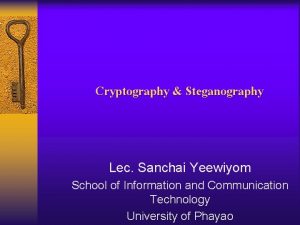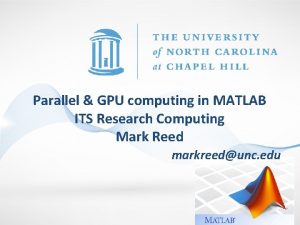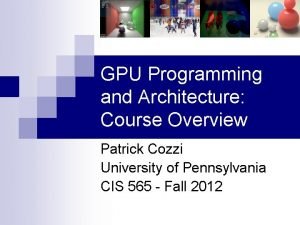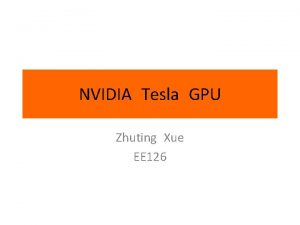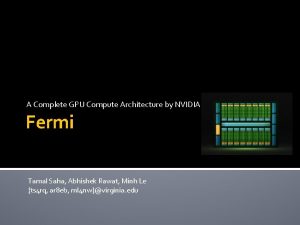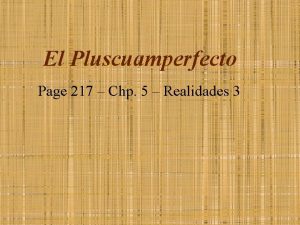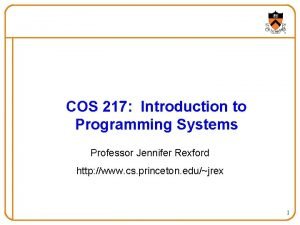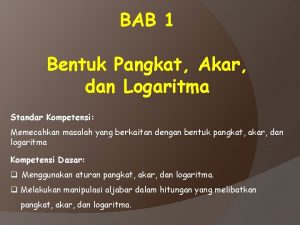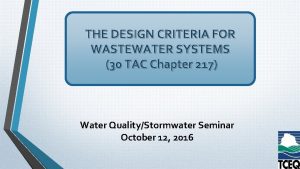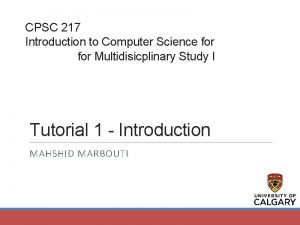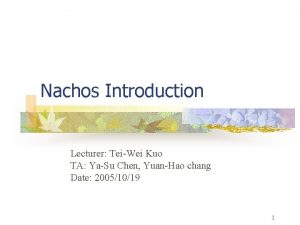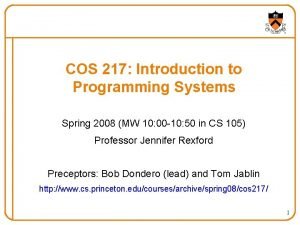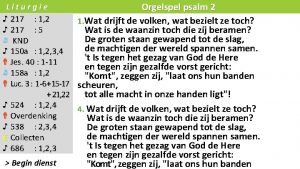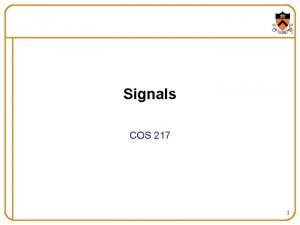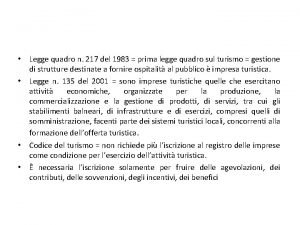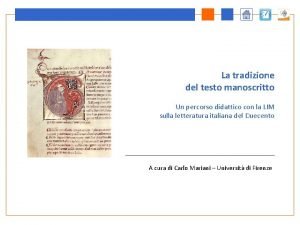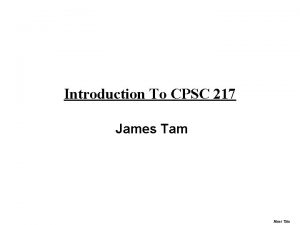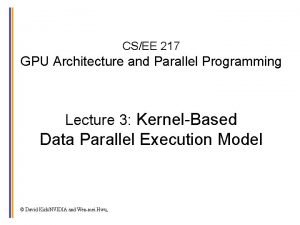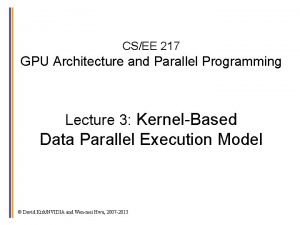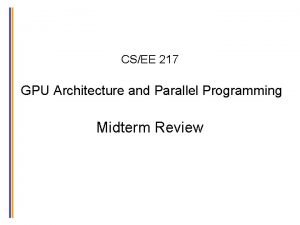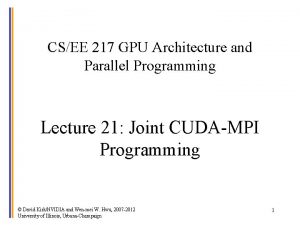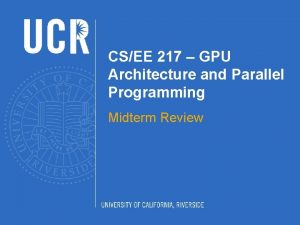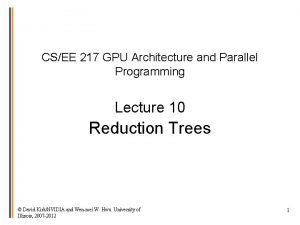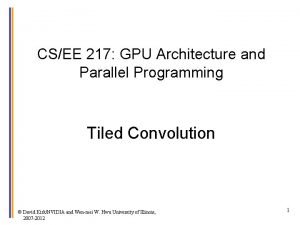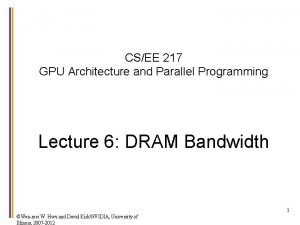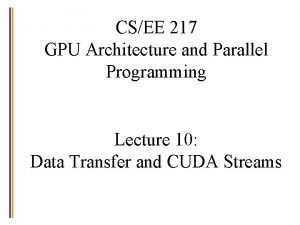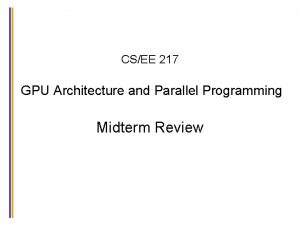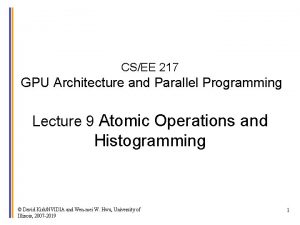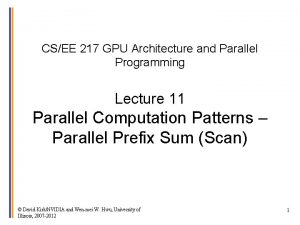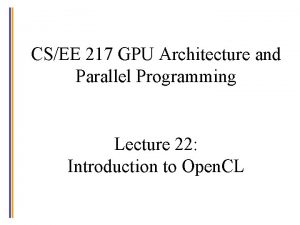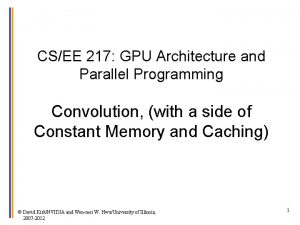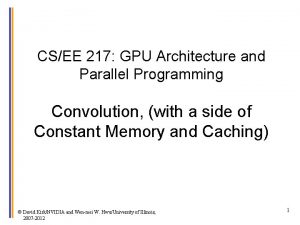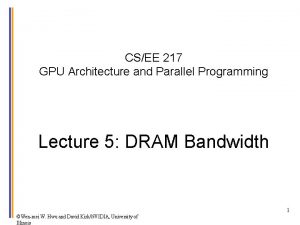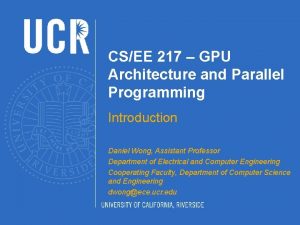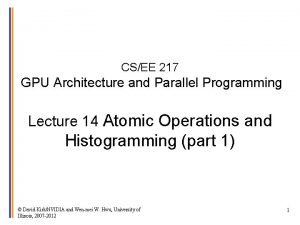CSEE 217 GPU Architecture and Parallel Programming Project



















- Slides: 19

CS/EE 217 GPU Architecture and Parallel Programming Project Kickoff © David Kirk/NVIDIA and Wen-mei W. Hwu, 2007 -2012 University of Illinois, Urbana-Champaign 1

Two flavors • Application – Implement/optimize an realistic application on GPGPUs • Architecture – Evaluate application performance at the architecture level and sensitivity to architectural features – Propose new features or algorithms 2

Two tracks • Basic project—essentially a larger lab. – Should involve significant coding/optimization but… – does not necessarily have to be original or research related work – Could just implement one of the default projects • Research project – Should review related work – Should have a goal of publishing a paper • Even if you don’t get there, that is ok – More formal project proposal – In return, you don’t have to take the final exam! 3

Application projects: Objective • To Build up your ability to translate parallel computing power into science and engineering breakthroughs – Identify applications whose computing structures are suitable for massively parallel execution – 10 -100 X more computing power can have transformative effect on these applications – Much better if you have a client • You can be the client – bringing an idea from your own research is encouraged. • Develop algorithm patterns that can result in both better efficiency as well as scalability 4

Future Science and Engineering Breakthroughs Hinge on Computing Computational Geoscience Computational Chemistry Computational Medicine Computational Modeling Computational Physics Computational Biology Computational Finance Image Processing 5

GPU computing is catching on.

GPU computing is catching on. Financial Analysis Scientific Simulation Engineering Simulation Data Intensive Analytics Medical Imaging Digital Audio Processing Digital Video Processing Computer Vision Biomedical Informatics Electronic Design Automation Statistical Modeling Ray Tracing Rendering Interactive Physics Numerical Methods • 280 submissions to GPU Computing Gems ~90 articles included in two volumes 7

Faster is not “just Faster” • 2 -3 X faster is “just faster” – – • 5 -10 x faster is “significant” – – • Do a little more, wait a little less Doesn’t change how you work Worth upgrading Worth re-writing (parts of) the application 100 x+ faster is “fundamentally different” – – Worth considering a new platform Worth re-architecting the application Makes new applications possible Drives “time to discovery” and creates fundamental changes in Science 8

How much computing power is enough? • Each jump in computing power motivates new ways of computing – Many apps have approximations or omissions that arose from limitations in computing power – Every 10 x jump in performance allows app developers to innovate – Example: graphics, medical imaging, physics simulation, etc. Application developers do not take it seriously until they see real results. 9

Why didn’t this happen earlier? • Computational experimentation is just reaching critical mass – Simulate large enough systems – Simulate long enough system time – Simulate enough details • Computational instrumentation is also just reaching critical mass – Reaching high enough accuracy – Cover enough observations 10

A Great Opportunity for Many • New massively parallel computing is enabling – Drastic reduction in “time to discovery” – 1 st principle-based simulation at meaningful scale – New, 3 rd paradigm for research: computational experimentation • The “democratization” of power to discover • $2, 000/Teraflop in personal computers today • $5, 000/Petaflops in clusters today • HW cost will no longer be the main barrier for big science • This is once-in-a-career opportunity for many! 11

VMD/NAMD Molecular Dynamics • 240 X speedup over sequential code • Computational biology 12

Matlab: Language of Science 15 X with MATLAB CPU+GPU http: //developer. nvidia. com/object/matlab_cuda. html Pseudo-spectral simulation of 2 D Isotropic turbulence 13

Prevalent Performance Limits Some microarchitectural limits appear repeatedly across the benchmark suite: • Global memory bandwidth saturation – Tasks with intrinsically low data reuse, e. g. vector-scalar addition or matrixvector multiplication product – Computation with frequent global synchronization • Converted to short-lived kernels with low data reuse • Common in simulation programs • Thread-level optimization vs. latency tolerance – Since hardware resources are divided among threads, low per-thread resource use is necessary to furnish enough simultaneously-active threads to tolerate longlatency operations – Making individual threads faster generally increases register and/or shared memory requirements – Optimizations trade off single-thread speed for exposed latency 14

What you will likely need to hit hard. • Parallelism extraction requires global understanding – Most programmers only understand parts of an application • Algorithms need to be re-designed – Algorithmic effect on parallelism and locality is often hard to maneuver • Real but rare dependencies often need to be pushed aside – Error checking code, etc. , parallel code is often not equivalent to sequential code • Getting more than a small speedup over sequential code is very tricky – ~20 versions typically experimented for each application 15

Ideas for projects • • Your own research! An application you are interested in. GPU computing Gems Parboil benchmark: Collections of best parallel programming projects for CPU/GPU computing http: //impact. crhc. illinois. edu/Parboil/parboil. aspx • Rodinia Benchmark • Talk to me if you are interested in architecture projects 16

Architecture Proposals • Either a workload evaluation study running workloads in a simulator – Explore impact of different architecture parameters on performance – Provide insights into what causes the differences in behavior • Propose and evaluate improvements – E. g. , warp scheduler competition http: //www. sigarch. org/2015/08/06/call-for-papers-1 st-gpuwarpwavefront-scheduling-championship/ 17

Project website come up soon • Deadlines and details of deliverables • Standard programming project • Standard architecture project (scheduler competition) 18

ANY MORE QUESTIONS? © David Kirk/NVIDIA and Wen-mei W. Hwu, University of Illinois, Urbana-Champaign 19
 Csee sg ida
Csee sg ida Gpgpu matlab
Gpgpu matlab Gpu architecture course
Gpu architecture course Tesla gpu architecture
Tesla gpu architecture Gpu architecture basics
Gpu architecture basics El pluscuamperfecto p 217
El pluscuamperfecto p 217 Cos217
Cos217 Bio 217
Bio 217 Persamaan 7 log 217 + 7 log 31 ialah
Persamaan 7 log 217 + 7 log 31 ialah 30 tac 217
30 tac 217 Multidisicplinary
Multidisicplinary 49 cfr 217
49 cfr 217 How to install nachos on linux in workstation room 217
How to install nachos on linux in workstation room 217 Cos217
Cos217 Psalm 217
Psalm 217 Signal handler
Signal handler Legge 217 del 1983
Legge 217 del 1983 Banco rari 217
Banco rari 217 James tam u of c
James tam u of c Cos217 spring 2021
Cos217 spring 2021
